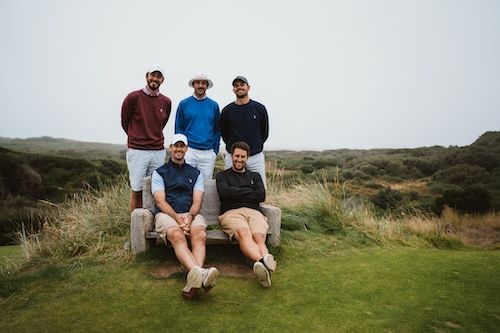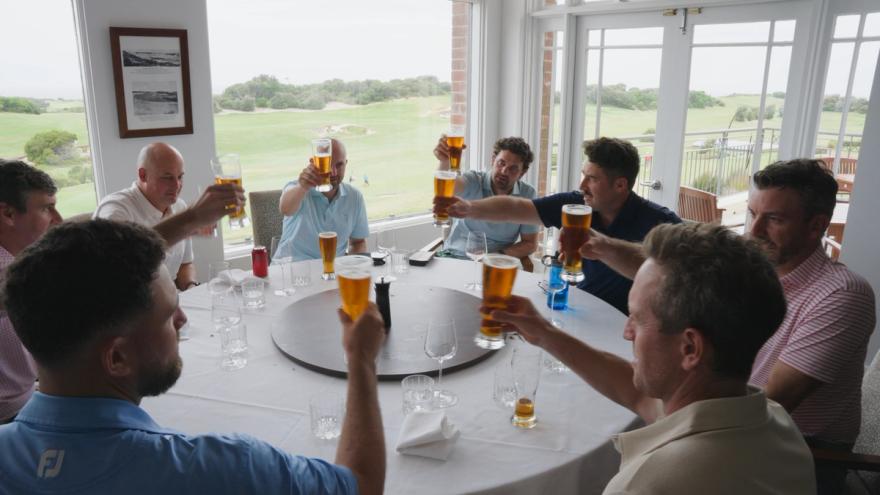LANCASTER — When Yuka Saso was a young girl, she would get out of bed each morning, and before heading off to school, she would grab a golf club and practice her swing in front of a mirror. She was determined to create a great swing and wanted to understand how she could get there.
When it was time to leave for school, she would reluctantly put the club down. But as soon as school was done, she would pick it up again. Her Japanese father, Masakazu, understood he had an obsessive genius growing up under his roof, and that Japan was not an environment where a girl of limited means could blossom into a golf prodigy. He moved the family back to the Philippines, where Saso was born and where her mother, Fritzie, had been raised. From the time school ended until it was too dark to see the ball, Saso would hit balls at the local course in Bulacan, yearning for something she couldn’t quite articulate.
“I lived inside the golf course when I started,” Saso said. “I think just staying a lot of times on the golf course or holding a golf club, pretty much 12 hours I think helps a little bit.”
At night, she would stand in front of the mirror again, holding positions, examining angles, creating a loop that might as well have been a propeller, pulling her toward her destiny.
In 2021, at age 19, she won the U.S. Women’s Open at Olympic Club, rising to the top of the leaderboard as a slew of seasoned players crumbled down the stretch.
On Sunday, Saso — now 22 years old — repeated that feat, winning her second U.S. Women’s Open, shooting a final round 68 at Lancaster Country Club to cruise to a three-shot victory. It did not feel like a surprise, even though Saso began the final round three shots behind Minjee Lee, a fellow U.S. Women’s Open champion, in part because no lead at Lancaster felt safe. Trouble lurked on virtually every hole, and the line between birdies and bogeys was razor-thin. But the difficult conditions were a welcome sight for Saso.
Even though she hadn’t won since 2021, she finished 2nd and T-3 in two of the majors last season. Put Saso on a course where everyone can make birdies and she’s a good player, but rarely a special one. Put her on a course like Lancaster, however, and there might be 10 players in the whole field who can match her skill set.
“We thought it was a good golf course for her because she hits it long and she hits it high, and she’s a great putter,” said Saso’s caddie Dylan Vallequette. “It felt like a big golf course.”
Never was that more evident than on the 15th hole Sunday. Saso found the fairway with her drive and had 188 yards to an uphill pin off an uneven lie. Instead of hitting a draw — the easier shot with the ball above her feet — Saso hit a cut 5-iron that climbed toward the clouds, then tumbled out of the sky and checked up, rolling out to five feet. She rolled in the putt for her third birdie in four holes, effectively wrapping up the championship.
“The tougher the golf course is, the better it is for her,” Vallequette said.
Friend and countrywoman Hinako Shibuno, who finished runner-up to Saso, feels Lancaster resembled a lot of what players from Japan are used to.
“I think part of the reason is they hit it very straight, and despite that this course is difficult. There's a lot of ups and downs and it's slopey. However, the greens here are somewhat similar to greens in Japan,” Shibuno said.
Even an early-round hiccup — a four-putt double bogey on the sixth hole that, at the time, left her four shots behind Lee — didn’t seem to rattle Saso. It had echoes of an early double she made at Olympic Club in 2021.
“I think that double is good luck,” Saso said.
Saso said she didn’t need a pep talk after the four putt on No. 6, she just tried to remember what Vallequette said to her before her round.
‘Before we started, he talked to me, [and said] whatever happens today, he'll be very proud of me. I think I remember that all the way,” Saso said. “I think that kind words of him helped me a lot.”
It was the kind of U.S. Women’s Open where pep talks and heartache were engaged in an endless tug of war. On Thursday, the championship had barely gotten started when Nelly Korda, the No. 1 player in the world and already the winner of six tournaments in 2024, suffered one of the most stunning ejections in recent memory, making a 10 on Lancaster’s devilish 12th hole, a downhill Par 3 with a creek guarding its front edge. Korda’s championship, and any preposterous-but-still-alluring dreams of sweeping the majors this year, sank when she knocked three balls in the water. (On the day, 52 players found the water on No. 12, nearly a third of the field.)
“I'm human. I'm going to have bad days,” Korda said.
As good as Korda has been this season, her week at Lancaster did reveal to the world that there are still areas of her game where she needs to get better, and this will only fuel that quest. Despite shooting 70 in the second round, she missed the cut in the U.S. Women’s Open for the third time in five years.
Subscribe to No Laying Up Emails
If you enjoy NLU content, you'll enjoy NLU emails. We send our newsletter twice a month, and we send a Weekly Digest email. Get monthly deals, exclusive content, and regular updates on all things No Laying Up #GetInvolved

“I really struggled off the tee this week,” Korda said. “Just wasn't getting it close. The majority of my holes I was saving pars.”
In Korda’s absence, it seemed like a great opportunity for Minjee Lee to return to the winner’s circle and claim her third major championship. She won the U.S. Women’s Open in 2022 and took control of the 2024 championship with a 66 on Saturday that looked almost too easy. Through three rounds, Lee had what felt like the shot of the tournament, a 6-iron into the 7th green that kicked off a mound and rolled to within a foot of the pin. She tapped in for an eagle and grabbed the lead she would take into Sunday.
“I feel like it’s all been coming together for the moment I’m in right now,” Lee said.
On Sunday, Lee did not look like the same player who had been flushing iron shots and splitting fairways. She birdied the first hole and held onto the lead despite some sloppy play early, but on the 9th hole, she drove it into the fairway bunker and had to pitch out. A bogey felt like a harbinger of things to come. Lee played a seven-hole stretch in 7-over-par, effectively ending any hopes of a second U.S. Women’s Open title before she’d even reached the final three holes. Like Korda, she found the water on the treacherous 12th hole.
“Obviously I'm going to acknowledge my disappointment and then come back stronger, take the positives out of the week,” Lee said. “It's a lot of pressure on the last day, so it wasn't my best performance but I'm sure there will be many better performances ahead.”
While most of the field was slowly melting, Saso kept splitting fairways and launching towering iron shots into Lancaster’s diabolical greens. She birdied the 12th and the 13th, then hit that majestic 5-iron into 15 for her third birdie in four holes. When she reached 16 — a short par 4 where the USGA moved the tees up to tempt players into going for the green — she decided there was no sense in laying up. She was laughing and joking with playing partner Sakura Koiwai while they waited for the green to clear, but once it did, Saso returned to her cocoon of calm and grabbed her 3-wood.
“I wasn't looking at the scoreboard,” Saso said. “I wasn't too relaxed to be able to see the scoreboard.”
She drew back the club and took a vicious lash at the ball, then watched as it knifed through the heavy summer air. She bent down to snatch her tee from the ground, knowing it was right online. She didn’t even need to see it finish. “As soon as I hit it I thought ‘That’s on the green for sure,’ ” Saso said. It landed nearly pin high, then rolled out to 16 feet. Two putts and a birdie later gave her a three-shot margin over Andrea Lee and the championship was all but wrapped up.
“I think I really wanted it,” Saso said. “Not just to get a second win but also to prove something to myself. I haven't won in two and a half or three years. I definitely had a little doubt if I could win again or if I won't win again.”
During the trophy ceremony, Saso was a little surprised when she started to tear up. The first time she won the U.S. Women’s Open, she’d been playing under the flag of the Philippines, to honor her mother. But in the last few years, she’s been playing under the flag of Japan, to honor her father.
“I think winning in 2021, it changed my life,” Saso said. “In a good way, but also, I had some challenges. But those challenges, I needed it. I was still young. I had so much to learn, both inside the golf course and outside the golf course. So whatever happened in those three years, even though it was not easy, I’m thankful that it happened.”
Saso doesn’t do much mirror work with her swing anymore. She prefers to work out various kinks on the range these days. But if she were to glance into a mirror on Monday, she’d see something satisfying and rewarding staring back at her: A two-time U.S. Open winner.
Kevin Van Valkenburg is the Editorial Director of No Laying Up
Email him at kvv@nolayingup.com
Join The Nest
Established in 2019, The Nest is NLU's growing community of avid golfers. Membership is only $90 a year and includes 15% off at the Pro Shop, exclusive content like a monthly Nest Member podcast and other behind-the-scenes videos, early access to events, and more newsletter-exclusive written content from the team when you join The Nest.
